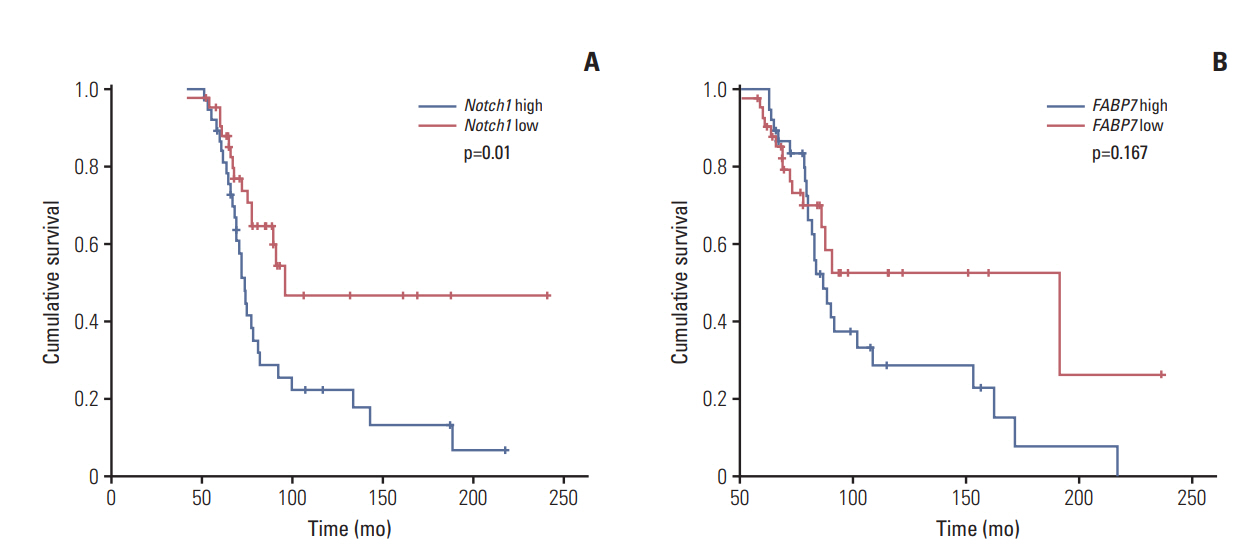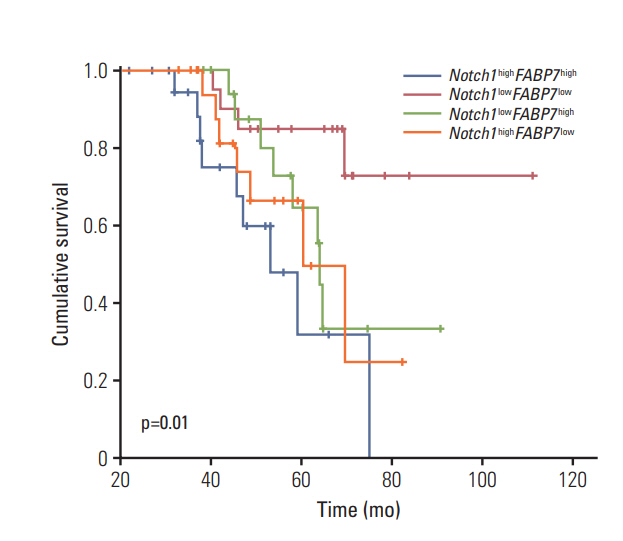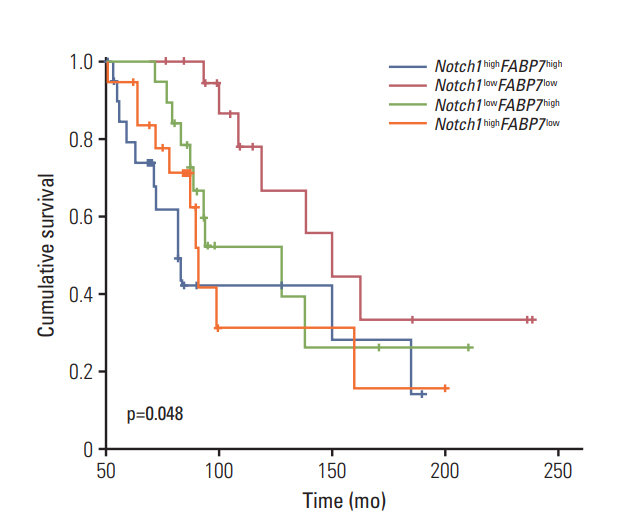Cancer Res Treat.
2018 Oct;50(4):1064-1073. 10.4143/crt.2017.337.
The Prognostic Significance of Notch1 and Fatty Acid Binding Protein 7 (FABP7) Expression in Resected Tracheobronchial Adenoid Cystic Carcinoma: A Multicenter Retrospective Study
- Affiliations
-
- 1Guangzhou Institute of Respiratory Disease, The First Affiliated Hospital of Guangzhou Medical University, Guangzhou, China. mianxie@gird.cn
- 2Department of General Surgery, Sun-Yet Sen University Cancer Center, Guangzhou, China.
- 3Department of Thoracic Surgery, The First Affiliated Hospital, Sun-Yet Sen University, Guangzhou, China.
- 4Department of Internal Medicine, Guangdong General Hospital, Guangdong Academy of Medical Science, Guangzhou, China.
- 5Department of Thoracic Surgery, The First Affiliated Hospital, Tsing Hua University, Beijing, China.
- 6Department of Medical Statistics, The First Affiliated Hospital of Guangzhou Medical University, Guangzhou, China.
- 7Department of Pathology, The First Affiliated Hospital of Guangzhou Medical University, Guangzhou, China.
- KMID: 2424779
- DOI: http://doi.org/10.4143/crt.2017.337
Abstract
- PURPOSE
Adenoid cystic carcinoma (ACC) of the trachea and bronchus is a rare tumor. Although MYB-NFIB oncogene fusion and Notch1 mutation have been identified in ACC, little is known about the expression and clinical significance of Notch1 and its target gene fatty acid binding protein 7 (FABP7) in tracheobronchial ACC.
MATERIALS AND METHODS
Primary tracheobronchial ACC that were resected between 1998 and 2014 were identified through the pathology and oncology database from five thoracic oncology centers in China. A tissue array was constructed from the patients' samples and the expressions of Notch1 and FABP7 were evaluated by immunohistochemistry. The association between the expression of both markers and survival was determined.
RESULTS
Overexpression of Notch1 and FABP7, detected in 37.8% and 38.3% of 368 patients with tracheobronchial ACC, respectively, was an independent prognostic indicator for recurrencefree survival (RFS) by multivariable Cox proportional hazard model (p=0.032 and p=0.048, respectively). Overexpression of Notch1, but not of FABP7, predicted overall survival (OS) (p=0.018). When categorized into four groups according to coexpression of Notch1 and FABP7, patients with overexpression of both Notch1 and FABP7 belonged to the group with the shortest RFS and OS (p=0.01 and p=0.048, respectively).
CONCLUSION
Expression of Notch1 and FABP7, and coexpression of Notch1 and FABP7, is strongly associated with poor survival in resected tracheobronchial ACC. These data are consistent with the hypothesis that poor differentiation of tracheobronchial ACC correlates with the activation of Notch signaling.
MeSH Terms
Figure
Reference
-
References
1. Xu LT, Sun ZF, Li ZJ, Wu LH, Zhang ZY, Yu XQ. Clinical and pathologic characteristics in patients with tracheobronchial tumor: report of 50 patients. Ann Thorac Surg. 1987; 43:276–8.
Article2. Nomori H, Kaseda S, Kobayashi K, Ishihara T, Yanai N, Torikata C. Adenoid cystic carcinoma of the trachea and mainstem bronchus: a clinical, histopathologic, and immunohistochemical study. J Thorac Cardiovasc Surg. 1988; 96:271–7.3. Grillo HC, Mathisen DJ. Primary tracheal tumors: treatment and results. Ann Thorac Surg. 1990; 49:69–77.
Article4. Li N, Xu L, Zhao H, El-Naggar AK, Sturgis EM. A comparison of the demographics, clinical features, and survival of patients with adenoid cystic carcinoma of major and minor salivary glands versus less common sites within the Surveillance, Epidemiology, and End Results registry. Cancer. 2012; 118:3945–53.
Article5. Maziak DE, Todd TR, Keshavjee SH, Winton TL, Van Nostrand P, Pearson FG. Adenoid cystic carcinoma of the airway: thirty-two-year experience. J Thorac Cardiovasc Surg. 1996; 112:1522–31.
Article6. Gaissert HA. Primary tracheal tumors. Chest Surg Clin N Am. 2003; 13:247–56.
Article7. Prommegger R, Salzer GM. Long-term results of surgery for adenoid cystic carcinoma of the trachea and bronchi. Eur J Surg Oncol. 1998; 24:440–4.
Article8. Drier Y, Cotton MJ, Williamson KE, Gillespie SM, Ryan RJ, Kluk MJ, et al. An oncogenic MYB feedback loop drives alternate cell fates in adenoid cystic carcinoma. Nat Genet. 2016; 48:265–72.
Article9. Roden AC, Greipp PT, Knutson DL, Kloft-Nelson SM, Jenkins SM, Marks RS, et al. Histopathologic and cytogenetic features of pulmonary adenoid cystic carcinoma. J Thorac Oncol. 2015; 10:1570–5.
Article10. Mitani Y, Rao PH, Futreal PA, Roberts DB, Stephens PJ, Zhao YJ, et al. Novel chromosomal rearrangements and break points at the t(6;9) in salivary adenoid cystic carcinoma: association with MYB-NFIB chimeric fusion, MYB expression, and clinical outcome. Clin Cancer Res. 2011; 17:7003–14.
Article11. West RB, Kong C, Clarke N, Gilks T, Lipsick JS, Cao H, et al. MYB expression and translocation in adenoid cystic carcinomas and other salivary gland tumors with clinicopathologic correlation. Am J Surg Pathol. 2011; 35:92–9.
Article12. Persson M, Andren Y, Mark J, Horlings HM, Persson F, Stenman G. Recurrent fusion of MYB and NFIB transcription factor genes in carcinomas of the breast and head and neck. Proc Natl Acad Sci U S A. 2009; 106:18740–4.
Article13. Mitani Y, Li J, Rao PH, Zhao YJ, Bell D, Lippman SM, et al. Comprehensive analysis of the MYB-NFIB gene fusion in salivary adenoid cystic carcinoma: Incidence, variability, and clinicopathologic significance. Clin Cancer Res. 2010; 16:4722–31.
Article14. Ho AS, Kannan K, Roy DM, Morris LG, Ganly I, Katabi N, et al. The mutational landscape of adenoid cystic carcinoma. Nat Genet. 2013; 45:791–8.
Article15. Bray SJ. Notch signalling: a simple pathway becomes complex. Nat Rev Mol Cell Biol. 2006; 7:678–89.
Article16. Phuchareon J, Overdevest JB, McCormick F, Eisele DW, van Zante A, Tetsu O. Fatty acid binding protein 7 is a molecular marker in adenoid cystic carcinoma of the salivary glands: implications for clinical significance. Transl Oncol. 2014; 7:780–7.
Article17. Hilsenbeck SG, Clark GM, McGuire WL. Why do so many prognostic factors fail to pan out? Breast Cancer Res Treat. 1992; 22:197–206.
Article18. Gaissert HA, Grillo HC, Shadmehr MB, Wright CD, Gokhale M, Wain JC, et al. Long-term survival after resection of primary adenoid cystic and squamous cell carcinoma of the trachea and carina. Ann Thorac Surg. 2004; 78:1889–96.
Article19. Azar T, Abdul-Karim FW, Tucker HM. Adenoid cystic carcinoma of the trachea. Laryngoscope. 1998; 108:1297–300.
Article20. Lin CM, Li AF, Wu LH, Wu YC, Lin FC, Wang LS. Adenoid cystic carcinoma of the trachea and bronchus: a clinicopathologic study with DNA flow cytometric analysis and oncogene expression. Eur J Cardiothorac Surg. 2002; 22:621–5.21. Grego-Bessa J, Diez J, Timmerman L, de la Pompa JL. Notch and epithelial-mesenchyme transition in development and tumor progression: another turn of the screw. Cell Cycle. 2004; 3:718–21.
Article22. Stephens PJ, Davies HR, Mitani Y, Van Loo P, Shlien A, Tarpey PS, et al. Whole exome sequencing of adenoid cystic carcinoma. J Clin Invest. 2013; 123:2965–8.
Article23. Ross JS, Wang K, Rand JV, Sheehan CE, Jennings TA, Al-Rohil RN, et al. Comprehensive genomic profiling of relapsed and metastatic adenoid cystic carcinomas by next-generation sequencing reveals potential new routes to targeted therapies. Am J Surg Pathol. 2014; 38:235–8.
Article24. Ferrarotto R, Mitani Y, Diao L, Guijarro I, Wang J, Zweidler-McKay P, et al. Activating NOTCH1 mutations define a distinct subgroup of patients with adenoid cystic carcinoma who have poor prognosis, propensity to bone and liver metastasis, and potential responsiveness to Notch1 inhibitors. J Clin Oncol. 2017; 35:352–60.25. van Weert S, van der Waal I, Witte BI, Leemans CR, Bloemena E. Histopathological grading of adenoid cystic carcinoma of the head and neck: analysis of currently used grading systems and proposal for a simplified grading scheme. Oral Oncol. 2015; 51:71–6.
Article26. Kluk MJ, Ashworth T, Wang H, Knoechel B, Mason EF, Morgan EA, et al. Gauging NOTCH1 activation in cancer using immunohistochemistry. PLoS One. 2013; 8:e67306.
Article27. Bell D, Hanna EY, Miele L, Roberts D, Weber RS, El-Naggar AK. Expression and significance of notch signaling pathway in salivary adenoid cystic carcinoma. Ann Diagn Pathol. 2014; 18:10–3.
Article28. Panaccione A, Chang MT, Carbone BE, Guo Y, Moskaluk CA, Virk RK, et al. NOTCH1 and SOX10 are essential for proliferation and radiation resistance of cancer stem-like cells in adenoid cystic carcinoma. Clin Cancer Res. 2016; 22:2083–95.
Article29. Storch J, Thumser AE. Tissue-specific functions in the fatty acid-binding protein family. J Biol Chem. 2010; 285:32679–83.
Article
- Full Text Links
- Actions
-
Cited
- CITED
-
- Close
- Share
- Similar articles
-
- Palliative Radiotherapy in a Patient with Pulmonary Adenoid Cystic Carcinoma
- A case of adenoid basal cell carcinoma in uterine cervix
- Adenoid Basal Carcinoma and Adenoid Cystic Carcinoma of the Uterine Cervix: A Study of 2 Cases
- Dedifferentiation in Adenoid Cystic Carcinoma of the Neck
- Skin Metastasis of Adenoid Cystic Carcinoma of Parotid Gland






